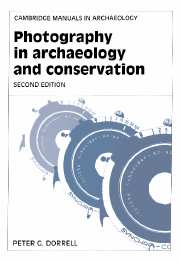Book contents
- Frontmatter
- Contents
- List of illustrations
- Preface
- Preface to the second edition
- Acknowledgements
- 1 The early days of archaeological photography
- 2 Basic principles and practice
- 3 Equipment
- 4 Lighting by flash
- 5 Photographic materials, processing and printing
- 6 Architecture and standing monuments
- 7 Survey photography
- 8 Site photography
- 9 Principles of object photography
- 10 Principles of close-up photography
- 11 Ultra-violet and infra-red photography
- 12 Photographing finds
- 13 Flat copy
- 14 Preparation of material for publication
- 15 The future
- References
- Index
9 - Principles of object photography
Published online by Cambridge University Press: 23 December 2009
- Frontmatter
- Contents
- List of illustrations
- Preface
- Preface to the second edition
- Acknowledgements
- 1 The early days of archaeological photography
- 2 Basic principles and practice
- 3 Equipment
- 4 Lighting by flash
- 5 Photographic materials, processing and printing
- 6 Architecture and standing monuments
- 7 Survey photography
- 8 Site photography
- 9 Principles of object photography
- 10 Principles of close-up photography
- 11 Ultra-violet and infra-red photography
- 12 Photographing finds
- 13 Flat copy
- 14 Preparation of material for publication
- 15 The future
- References
- Index
Summary
This chapter is concerned mainly with the photography of movable artifacts, neither so large that they have to be photographed in situ nor so small that they need the techniques of close-up photography (this is dealt with in the next chapter). For all such objects the same principles of lighting and arrangement apply, and the same sort of information should be recorded by the camera.
The aims should be to record the maximum amount of accurate information, and to avoid distortions of shape, proportion, texture and colour. Ideally, it should be as informative to compare photographs of two objects as to compare the objects themselves, and although this ideal may be unattainable, differences between the photographs should at least reflect real differences between the objects and not just vagaries of the photographer. A further requirement is that photographs of artifacts, and particularly of artifacts which in some way constitute a group or assemblage, or ‘before and after’ photographs of objects undergoing conservation, should be as standardised as possible. If all are lit in approximately the same way, taken from similar viewpoints and against similar backgrounds, the images will be the more easily comparable and the eye will not be distracted by differences that are not related to the objects themselves.
Equipment
Cameras
The advantages and drawbacks of different camera formats are discussed in Chapter 3; they apply equally in object photography as in the field. Largeformat cameras can record finer detail, films can be processed individually, and foreshortening can be prevented by the use of camera-movements.
- Type
- Chapter
- Information
- Photography in Archaeology and Conservation , pp. 154 - 176Publisher: Cambridge University PressPrint publication year: 1994



